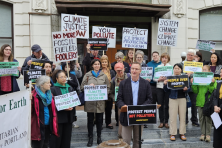Boundaries of potential Oregon Wind Energy Areas published
Oregon could benefit from new source of clean energy to reduce climate pollution and reduce fossil fuel dependency
The Bureau of Ocean Energy Management (BOEM) on Tuesday released two draft Wind Energy Areas (WEAs) for floating offshore wind development off Oregon’s South Coast, a key step in the effort to reduce our reliance on fossil fuels that heat the planet and accelerate the climate crisis. Climate advocates across Oregon lauded the step.
The two draft WEAs are located between 18 and 32 nautical miles off the coast of Coos Bay and Brookings. The areas were narrowed down from broader “call areas'' based on extensive public comment, study, and review.
“The release of the draft wind energy areas is an important milestone for the potential deployment of floating offshore wind off the coast of Oregon,” said Nicole Hughes, Executive Director of Renewable Northwest, a regional renewable energy advocacy organization. “We are at the beginning of a multi-year process to consider the impacts and benefits of floating offshore wind as part of Oregon's strategy to achieve our energy, climate, and economic goals.”
Across the United States and around the world, offshore wind exploration and development is well underway. Two years ago, President Biden set a goal of 30 gigawatts of offshore wind electricity generation by 2030, which would power more than 10 million American homes with clean energy and generate new family wage jobs in communities across the country. Here in Oregon, the South Coast is home to some of the strongest sustained winds in the world and Gov. Tina Kotek has identified offshore wind as a possible “key component” in meeting the state’s climate goals – including a 2021 law that requires 100% clean electricity by 2040.
“Responsibly developed offshore wind holds significant potential for addressing the climate crisis,” said Meredith Connolly, Oregon Director at Climate Solutions. “Oregon is already acutely feeling the effects of the climate crisis: devastating wildfires, painful water shortages, and deadly extreme temperatures. We have to take bold, strategic action to reduce climate-heating pollution and make our communities more resilient. Offshore wind, in combination with other needed renewable energy resources, is one of the most promising tools we have to do just that.”
As climate change has warmed the ocean, Oregon’s iconic fishing industries have also struggled with large marine life die-offs and unpredictable seasons. Just this summer, a marine heatwave headed for the Oregon Coast has already threatened razor clams and other shellfish — and the Dungeness crab and other marine life that rely on them.
“The climate crisis continues to have a devastating impact on the Oregon Coast, threatening our way of life,” said Arnie Roblan, retired Oregon State Senator representing the South Coast. “I urge Oregonians on the coast to speak up and get involved in the offshore wind process to ensure that any project is responsibly developed and delivers the maximum benefits to our local economy and communities.”
Today marks the start of a 60-day public comment window, during which Oregonians are encouraged to offer feedback on the wind energy areas. Gov. Kotek successfully requested that BOEM extend the period for public comment and review by 30 days, a move supported by stakeholders.
“An effective and inclusive stakeholder process and Tribal consultation is absolutely essential to a successful process around exploring the development of floating offshore wind in Oregon,” said Diane Brandt, Oregon State Director of Renewable Northwest.
Once BOEM receives feedback on the draft WEAs from state agencies, Tribal governments, community members, the fishing industry, and local leaders, it will issue final WEAs that will mark the boundaries of areas for analysis to determine the environmental impacts of offshore wind development. This process will also include opportunities for stakeholders to weigh in on BOEM’s analysis, findings and recommended mitigation.
###





